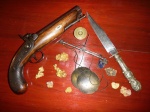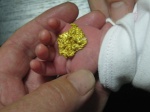Question on cleaning specimens- help required
4 posters
Page 1 of 1
 Question on cleaning specimens- help required
Question on cleaning specimens- help required
I have two specimens that I wanted to clean up a bit as the gold content was high but the visible gold was low.
Both have some quartz but mostly iron stone coated and some rock, I'm happy for the quartz to stay but want to dissolve the rock and ironstone.
I have done the smaller one and put it in straight hydrochloric acid in a glass jar and put in plenty of acid and after a while the acid started to turn yellow but then the action started to slow right down with nothing more happening.
I thought the acid was spent but found when I pulled out the specimen and gave it a scrub and put it back in the same acid started to work again and the job was done with a good result but took a few days to do.
My first question is - when the acid acts on a specimen and starts removing material does this process soon build up a layer of something that prevents the acid from working further and you have to give the specimen a light scrub to remove this then just put it back in to continue the process.
My next question is what to do with the acid after - I was simply going to dig a hole out the back and pour the acid in and pour some water mixed with bi- carb soda over the top and fill in the hole and also what gas is given off as the wind direction changed and I took a breath and boy it's nearly knocked me off my feet.
It would be good to get some answers as I'm still in the process with the larger specimen and still a bit confused with how all this is done.
Cheers Mark
Both have some quartz but mostly iron stone coated and some rock, I'm happy for the quartz to stay but want to dissolve the rock and ironstone.
I have done the smaller one and put it in straight hydrochloric acid in a glass jar and put in plenty of acid and after a while the acid started to turn yellow but then the action started to slow right down with nothing more happening.
I thought the acid was spent but found when I pulled out the specimen and gave it a scrub and put it back in the same acid started to work again and the job was done with a good result but took a few days to do.
My first question is - when the acid acts on a specimen and starts removing material does this process soon build up a layer of something that prevents the acid from working further and you have to give the specimen a light scrub to remove this then just put it back in to continue the process.
My next question is what to do with the acid after - I was simply going to dig a hole out the back and pour the acid in and pour some water mixed with bi- carb soda over the top and fill in the hole and also what gas is given off as the wind direction changed and I took a breath and boy it's nearly knocked me off my feet.
It would be good to get some answers as I'm still in the process with the larger specimen and still a bit confused with how all this is done.
Cheers Mark

MS- Contributor Plus

- Number of posts : 791
Age : 58
Registration date : 2009-03-17
 Re: Question on cleaning specimens- help required
Re: Question on cleaning specimens- help required
Mark,
Safety first, don't ever breath any fumes in!!! and don't get in the habit of using Glass containers Plastic is much safer, I know you are only using Hydrochloric but if ever you were to put Hyroflouric in Glass it would eat through it and you would be in serious danger. I only mention Hydroflouric as an example you are much better off leaving that stuff well alone.
Regards
John
Safety first, don't ever breath any fumes in!!! and don't get in the habit of using Glass containers Plastic is much safer, I know you are only using Hydrochloric but if ever you were to put Hyroflouric in Glass it would eat through it and you would be in serious danger. I only mention Hydroflouric as an example you are much better off leaving that stuff well alone.
Regards
John

Tui65- Contributor

- Number of posts : 23
Registration date : 2008-10-21
 Re: Question on cleaning specimens- help required
Re: Question on cleaning specimens- help required
Hi,
There's a thread on here called "cleaning nuggets" search that and have a read of the thread. That will answer some of your questions. I had my nuggets sitting in a jar of sulphuric acid in front of me at work today. The ironstone is not being disolved from the outside in. It is just breaking down and becoming soft so after a swim in the bi-carb, the ironstone comes off in the ultrasonic. I'd like to know whats happening to it and if the sulfuric is the right stuff. Its all I have. I'm going to research it.
Dicko..
There's a thread on here called "cleaning nuggets" search that and have a read of the thread. That will answer some of your questions. I had my nuggets sitting in a jar of sulphuric acid in front of me at work today. The ironstone is not being disolved from the outside in. It is just breaking down and becoming soft so after a swim in the bi-carb, the ironstone comes off in the ultrasonic. I'd like to know whats happening to it and if the sulfuric is the right stuff. Its all I have. I'm going to research it.
Dicko..

chopppacalamari- Contributor Plus

- Number of posts : 660
Registration date : 2008-12-13
 Re: Question on cleaning specimens- help required
Re: Question on cleaning specimens- help required
Dicko I've got some Hydrocloric plus some Alibrite, remind me to bring some with me next trip...the way you're going you'll need heaps 
MS, I use hydrocloric to eat the ironstone but brighten and leave the quartz. If I want the quartz gone too, a few days or a week in the Alibrite does the trick
MS, I use hydrocloric to eat the ironstone but brighten and leave the quartz. If I want the quartz gone too, a few days or a week in the Alibrite does the trick
Guest- Guest
 Re: Question on cleaning specimens- help required
Re: Question on cleaning specimens- help required

Hi Mark: It's a bit like your ultrasonic cleaner not working on the grime deep down on an item unless it's all wet and immersed. This particular acid can't penetrate the ironstone very fast so it only goes as far as it can into the exposed surfaces.
Sulfuric acid is not really ideal for cleaning nuggets but Oxalic acid certainly is... though it's MUCH more milder. Oxalic acid is from the dicarboxylic acid range so it's considered to be in the range of very strong acids - but without the high risks as Hf. It really goes to town on metal ions which is why it is so effective on removing ironstone but on gold it has no reaction as gold is chemically inert. Re :Oxalic Acid, I bought some from the Miners Den as a customer about three or four years ago and still keep a couple of liters of the dry stuff in my garage for use just on cleaning gold - that bottle has lasted me for a few years and it's still more than half full. I've also asked a number of old-timer prospectors (no offense if they're reading this) about the use of hydrochloric acid for nuggets and they all shook their heads and recommended pretty much anything else. I think that it should destroy the ironstone much the same way as rust killers etch away the oxidized surfaces that are exposed to the acid. And Hydrofluoric acid (used for cleaning larger specimens quickly) is one of those things so deadly that the FBI want it to be listed as a weapon-grade material and want it removed from public access. It serves a lot of uses like tire cleaner and glass etcher but those products may be available in milder forms like Allbright (SP?) (not sure if you can still get this). There's a shop in Kalgoorlie that was next to the pub a few years ago that sold the more serious acids like HF. No idea if it's still there. Can you imagine having a car accident with Hydrofluoric in the vehicle?!
You'll want to use milder acids for minor inclusions of host rock, even though they take much longer to achieve their results compared to hydrofluoric. Unfortunately the Hydrofluoric is so strong that it will demolish everything but the gold because it is inert and won't react to many things, let alone most acids. You'll need to find an appropriate way to dispose of the neutralized acid when you're done too. It will eat through he pipes if you don't and it will destroy steel, iron, bones, glass and just about anything else you want to throw in it. Hence it's used by criminals even today to dispose of evidence. If you are in a hurry - contact someone that uses the harsher stuff regularly if you can find them. Speak to a professional jeweler or nugget dealer and have them handle the more dangerous acids. Two drops on the body are enough to seep through to the bone and trigger destruction of the marrow and then the resulting blood poisoning will kill you before the limb is completely destroyed. The reason it does this is because the fluorons of the acid pass through the skin intact and then leech directly towards the nearest calcium source. A calcium splint and drip has saved many a limb and person when the damage is caught early but most acid burns don't present symptoms until the damage is done. Sure, some people survive the injures with medical assistance but many die from the smallest exposure... just a few drops on the body can be enough. Some fatalities can be near instantaneous if the acid is accidentally ingested in volume (as happened to the daughter of a prospector who foolishly stored his in the kitchen in a mineral water bottle). Should be plenty of threads on this although I haven't searched the forum here for them. I'm currently writing a general safety article on nugget cleaning and there's a lot of really useful techniques, methods and catalysts out there that can be used.
Numerous prospecting supply stores carry oxalic acid. Bleach will brighten up other specimens where quartz is involved but the removal of ironstone can usually be achieved with the fluids used for cleaning concrete and removing rust stains as they contain a watered down version of Hydrofluoric acid... but at milder concentrations. You need to store some acids in PET plastic containers as they will quickly eat through glass and even the vapor will score and destroy the corneas of the eyes. You can also run iron stained nuggets through the dishwasher when you put the pellet type detergents in to clean the dishes... this has the effect of brightening up stained nuggets to more attractive levels. I'm guessing there's a mild watered-down Hf content in some of those pellets.
When it comes to hard-rock encompassing a nugget entirely, you'll need to use harsher methods or crush it to extract the gold. Some intricate nuggets can certainly be extracted from specimens (when the host rock is removed carefully) and many beautiful nuggets circulating on the market today have been etched free of other material to show them in a better light. Be absolutely sure not to mix liquids in the wrong order and be rigid in safety when handling acids. Plenty of examples on the internet of what happens when people get just a smudge of the wrong acid on their hands from a bottle. Good luck with the cleaning process. I know it's always tempting to clean nuggets but remember that Europeans are starting to ignore nuggets for sale that have no natural inclusions in them due to the fakes (real gold but hand made) that are on the market. Of course now the scammers have worked out how to pour gold into fissured quartz to fake even the specimens without shattering the "host rock" - probably by embedding the quartz in sand to dissipate the heat the way opals are set in gold without shattering them.
To recap, try to avoid having to bring home any of the really nasty acids and pay someone to do the job for you if they have the experience and materials. I store my mercury and acids in the garage so that any accidental spills will not risk my home environment. It's not nice to have to don gauntlets and facemasks etc to handle this stuff in summer. There is something enjoyable about working with hazardous materials that I can't explain but my wife keeps that aspect well tempered. No doubt the x-rays and radioactive minerals on the shelf behind me will get to me before any acid does. At least I hope that's what happens.
All the best with the nugget cleaning, no matter what method or materials you choose to employ for the job. As noted above, there ought to be a few threads on this someplace.
Regards,
Marco
PS: The image linked above is from Season 1 of the innovative television series "Breaking Bad". The scene depicts the cleanup of Hf Acid etc after one of the lead characters mistakenly uses the enamel bathtub in his upstairs bedroom to handle the disposal of a body and several guns.


nero_design- Contributor Plus

- Number of posts : 2090
Registration date : 2008-11-18
 Re: Question on cleaning specimens- help required
Re: Question on cleaning specimens- help required
Thanks for the reply s
I took the larger specimen out today and the acid broke down the rock and ironstone but left behind a thick coating of a brown to grayish deposit , the gold and quartz was untouched and simply gave it a scrub and used a pointed wooden skewer which easily lifted off the deposit.
The acid obviously wouldn't dissolve this what ever it is and leaves it behind .
Anyway job done and thanks again
Cheers Mark
I took the larger specimen out today and the acid broke down the rock and ironstone but left behind a thick coating of a brown to grayish deposit , the gold and quartz was untouched and simply gave it a scrub and used a pointed wooden skewer which easily lifted off the deposit.
The acid obviously wouldn't dissolve this what ever it is and leaves it behind .
Anyway job done and thanks again
Cheers Mark

MS- Contributor Plus

- Number of posts : 791
Age : 58
Registration date : 2009-03-17
 Similar topics
Similar topics» Cleaning specimens
» OziExplorer - Map help required.
» suspected gold specimens...
» Gold Specimens with the GPZ
» $5000 limit buy - no personal details required?
» OziExplorer - Map help required.
» suspected gold specimens...
» Gold Specimens with the GPZ
» $5000 limit buy - no personal details required?
Page 1 of 1
Permissions in this forum:
You cannot reply to topics in this forum